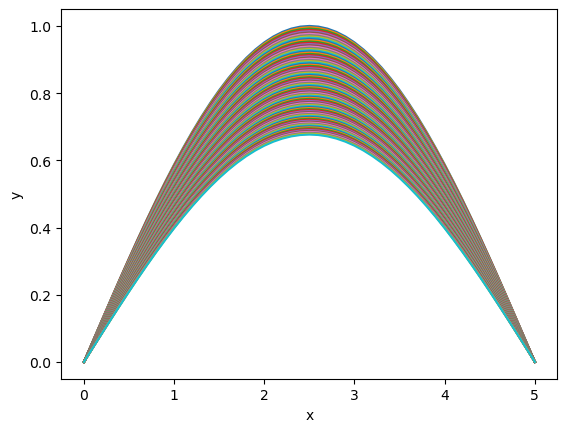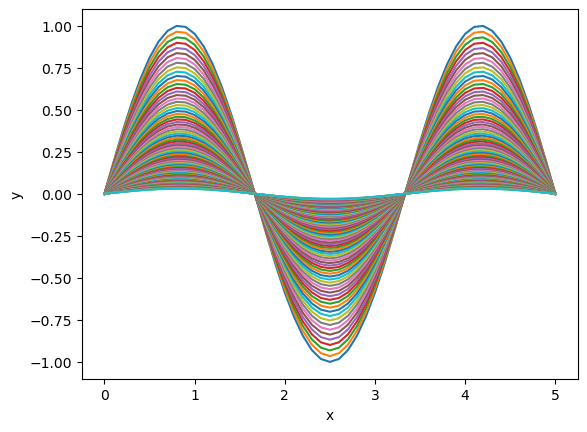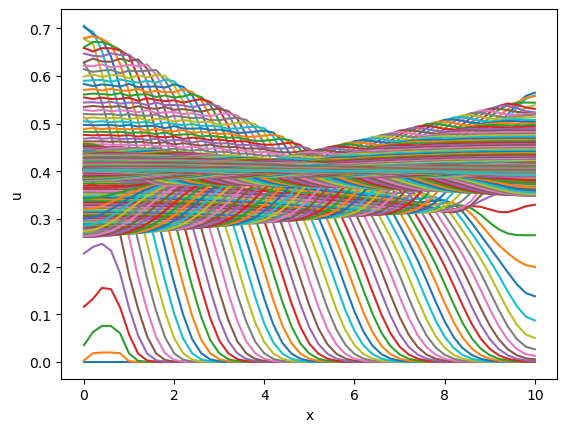7. Partial Differential Equations: Exercise Solutions#
import numpy as np
import matplotlib.pyplot as plt
%matplotlib inline
from scipy.integrate import odeint
1. Diffusion Equation#
For the diffusion equation with Dirichlet boundary condition, take initial states with different spatial frequencyes, such as $\( y(x, 0) = \sin(\frac{nx}{L}\pi ) \)\( with different \)n$, and see how quickly they decay in time.
def diff1D(y, t, x, D, inp=None):
"""1D Diffusion equaiton with constant boundary condition
y: state vector
t: time
x: positions
D: diffusion coefficient
input: function(y,x,t)"""
dx = x[1] - x[0] # space step
# shift to left and right and subtract
d2ydx2 = (y[:-2] -2*y[1:-1] + y[2:])/dx**2
# add 0 to both ends for Dirichlet boundary condition
d2ydx2 = np.hstack((0, d2ydx2, 0))
if inp == None:
return D*d2ydx2
else:
return D*d2ydx2 + inp(y, x, t)
Lx = 5 # length
N = 50
x = np.linspace(0, Lx, N+1)
D = 0.1 # diffusion constant
ts = 10
dt = 0.1
t = np.arange(0, ts, dt)
n = 1 # frequency
y0 = np.sin(n*np.pi*x/Lx) # initial condition
y = odeint(diff1D, y0, t, (x, D))
p = plt.plot(x, y.T)
plt.xlabel("x"); plt.ylabel("y");

n = 3 # frequency
y0 = np.sin(n*np.pi*x/Lx) # initial condition
y = odeint(diff1D, y0, t, (x, D))
p = plt.plot(x, y.T)
plt.xlabel("x"); plt.ylabel("y");

2. Wave Equation#
While the wave equation with Dirichlet boundary condition simulates oscillation of a string, that with Neumann condition $\( \left.\frac{\partial y(x,t)}{\partial x}\right|_{x_0}=\left.\frac{\partial y(x,t)}{\partial x}\right|_{x_N}=0 \)$ can simulate water wave.
Implement a wave equation with a decay term $\( \frac{\partial^2 u}{\partial t^2} = c^2 \frac{\partial^2 u}{\partial x^2} - d \frac{\partial u}{\partial t} \)$ with the Neumann boundary conditions and see how the wave ripples.
def wave1N(y, t, x, c, d, inp=0.):
"""1D wave equaiton with constant boundary
y: state vector hstack(u, v)
t: time
x: positions
c: wave speed
input: function(y,x,t)"""
n = int(len(y)/2)
u, v = y[:n], y[n:]
dx = x[1] - x[0]
# Neuman boundary conditions
d2udx2 = (np.r_[u[1],u[:-1]] -2*u + np.r_[u[1:],u[-2]])/dx**2
dvdt = c**2*d2udx2 - d*v + (inp(y,x,t) if callable(inp) else inp)
return np.r_[v, dvdt]
See how the waves vary with the initial condition or stimulum.
def pulse(y, x, t, xp=[0,1], tp=[0,1]):
"""1 for 0<x<1 at 0<t<1"""
return (xp[0]<x)*(x<xp[1])*(tp[0]<t)*(t<tp[1])*1.
Lx = 10
N = 50
x = np.linspace(0, Lx, N+1)
y0 = np.zeros(2*(N+1)) # initial condition
#y0[10:20] = 0.1 # a peak
c = 1. # wave speed
d = 0.2 # damping
ts = 50
dt = 0.2
t = np.arange(0, ts, dt)
y = odeint(wave1N, y0, t, (x, c, d, pulse))
plt.plot(x, y[:,:N+1].T)
plt.xlabel("x"); plt.ylabel("u");

%matplotlib notebook
fig = plt.figure(figsize=(8, 8))
ax = fig.add_subplot(projection='3d')
T, X = np.meshgrid(t, x)
ax.plot_surface(T, X, y[:,:N+1].T, cmap='viridis')
plt.xlabel("t"); plt.ylabel("x");
from matplotlib import animation
fig = plt.figure()
frames = [] # prepare frame
for i, ti in enumerate(t):
p = plt.plot(x, y[i,:N+1])
plt.xlabel("x"); plt.ylabel("y");
frames.append(p)
anim = animation.ArtistAnimation(fig, frames, interval = 10)
Optional: Wave equation in 2D#
Try simulating waves in a 2D space with a cyclic boundary condition.
def wave2C(y, t, x, c, d, inp=0):
"""2D Wave equaiton with Cyclic boundary condition
y: 2*n*n dim state vector hstack(u, v)
t: time
x: positions (x0, x1): transposed meshgrid
D: diffusion coefficient
inp: function(y,x,t) or number"""
n = x.shape[:2] # grid size (n0, n1)
nn = n[0]*n[1] # grid points n0*n1
u = y[:nn].reshape(n) # 2D grid
v = y[nn:].reshape(n)
dx = [x[1,0,0]-x[0,0,0], x[0,1,1]-x[0,0,1]] # space step
# Laplacian with Cyclic boundary
Lu = (np.roll(u,-1,0) + np.roll(u,1,0) + np.roll(u,-1,1) + np.roll(u,1,1) - 4*u)/dx[0]**2
dvdt = c**2*Lu - d*v + (inp(y,x,t) if callable(inp) else inp)
return np.r_[v, dvdt].ravel()
L = 10
N = 20
X = np.meshgrid(np.linspace(0,L,N), np.linspace(0,L,N))
x = np.array(X).transpose(2,1,0) # (x0,x1) in last dimention
y0 = np.zeros((2,N,N)) # initial condition
y0[0,2:4,5:8] = 1 #
c = 0.2 # wave speed
d = 0.1 # damping
ts = 100
dt = 0.2
t = np.arange(0, ts, dt)
y = odeint(wave2C, y0.ravel(), t, (x, c, d))
fig = plt.figure(figsize=(8,3))
for i in range(10):
plt.subplot(2, 5, i+1)
plt.imshow(y[10*i,:N*N].reshape(N,N).T, vmin=-0.2, vmax=1);
fig = plt.figure()
frames = [] # prepare frame
for i, ti in enumerate(t):
p = plt.imshow(y[i,:N*N].reshape(N,N).T, vmin=-0.2, vmax=1)
frames.append([p])
anim = animation.ArtistAnimation(fig, frames, interval = 10)
plt.xlabel("x1"); plt.ylabel("x2");
/Users/doya/miniforge3/lib/python3.13/site-packages/matplotlib/animation.py:908: UserWarning: Animation was deleted without rendering anything. This is most likely not intended. To prevent deletion, assign the Animation to a variable, e.g. `anim`, that exists until you output the Animation using `plt.show()` or `anim.save()`.
warnings.warn(
fig = plt.figure(figsize=(6,6))
ax = fig.add_subplot(projection='3d')
frames = [] # prepare frame
for i, ti in enumerate(t):
p = ax.plot_surface(X[0], X[1], y[i,:N*N].reshape(N,N).T, cmap='viridis')
frames.append([p])
anim = animation.ArtistAnimation(fig, frames, interval = 10)
plt.xlabel("x1"); plt.ylabel("x2");


